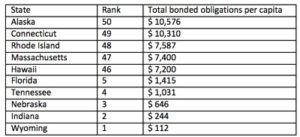1.1 Trillion Reasons to Remember State and Local Bond Obligations
Note: This Article Originally Appeared in The Hill.
We can all agree that we want our states and cities to avoid the painful lessons collectively learned from the recent bankruptcies in places like Detroit, Puerto Rico and the California cities of Stockton and San Bernardino.
While unfunded pension liabilities in those locations received a lion’s share of the news coverage, one topic that has unfortunately flown under the radar is the $1.1 trillion in bonded obligations issued across the 50 states and within their component units of government.
The good news from our report is that Nebraska, Indiana and Wyoming all carry far less than $1,000 in bonded obligations per resident, and fiscally responsible states like Florida and Tennessee place just behind.
Today, 11 states prohibit or place significant barriers to the issuance of general obligation bonds, which are supported with the general taxing power of the state and secured with the full faith and credit of the state.
On the other hand, states like Alaska and Connecticut have more than $10,000 of bonded obligations for every man, woman and child in their states. Rhode Island, Massachusetts and Hawaii, no strangers to state and municipal financial challenges, round out the bottom of the list.
While those levels of bonded obligations should be concerning, states structure their obligations in very different ways. For instance, Connecticut issued 62 percent of their total bonds as general obligation bonds. Alaska, on the other hand, issued 69 percent of their total bonds as component bonds.
This means that a greater portion of Alaska’s bond obligations can likely be restructured without encumbering taxpayers. Additionally, Alaska also does a far better job of maintaining a substantial budget stabilization of $4.7 billion, and their Permanent Fund, about $88,000 per capita ($65 billion), safeguards the state from a potential fiscal crisis from its large total of bonded obligations.
Several key lessons emerge from our research. First and foremost, it really brings us back again to finance or accounting 101, as it is essential to balance assets with liabilities. State budget stabilization funds are an important tool and can be improved by matching them to the state’s revenue volatility to prepare for the next economic downturn.
Furthermore, states should attempt to pay down debt during good economic times to maintain future flexibility when economic conditions worsen. This has the added benefit of creating the flexibility to issue bonds during periods of very low interest rates, such as recessions.
Lastly, states should utilize revenue bonds that are funded with user fees. States that pursued these strategies tended to have less damaging bonded obligations, particularly relative to their assets. To see how your state ranks, check the State Profiles section of State Bonded Obligations, 2018.
There are countless aspects of the American experiment worth celebrating, but few have been so beneficial as the decentralized structure of our federalist system. States can indeed learn from mistakes in highly publicized bankruptcies.
While most of the national media attention has been devoted to unfunded state pensions, where the magnitude of liabilities is staggering, we have $1.1 trillion reasons to remember the massive bonded obligations that are carried on the books state and local governments across America.


